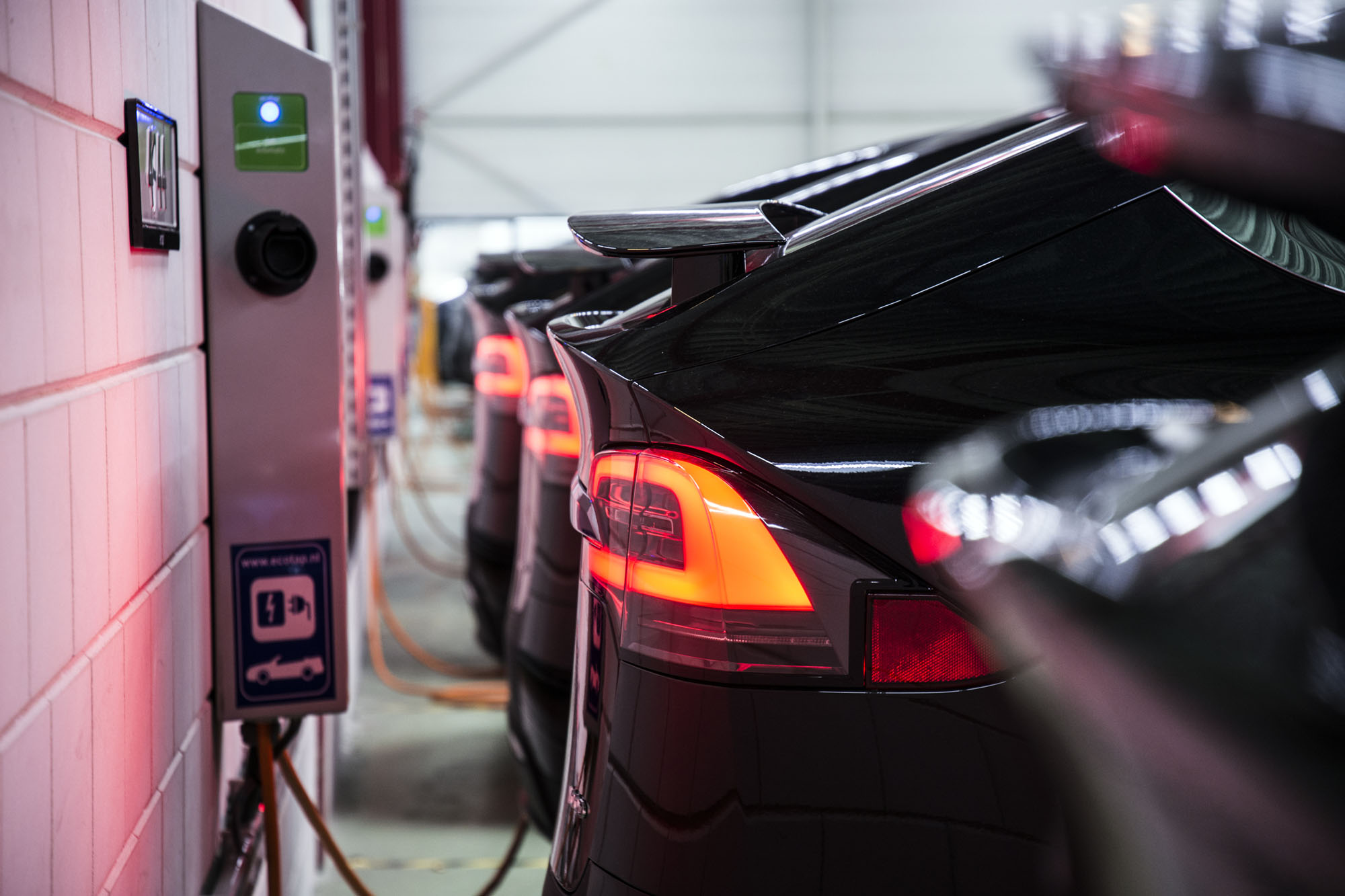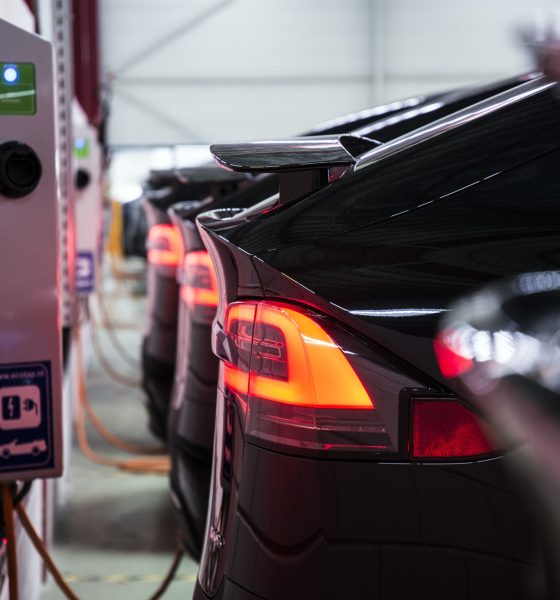

Energy
Tesla may revisit vehicle-to-grid (V2G) bi-directional charging solution
Tesla could soon revisit the idea of using its electric cars as a battery power source, likely as part of the company’s Vehicle-To-Grid (V2G) bi-directional solutions.
Musk’s update came as a response to a Twitter request from Cody Walker, a Tesla enthusiast, who inquired if the electric car maker would eventually introduce a feature where one car can provide battery power to another vehicle. Responding to the inquiry, Musk noted that previous Tesla vehicles had the capability to use its battery for outputting power.
Very early on, we had the ability to use the car as a battery outputting power. Maybe worth revisiting that.
— Elon Musk (@elonmusk) July 4, 2018
The Vehicle-To-Grid concept involves the use of electric car batteries to provide electricity back to the grid. The V2G model uses excess capacity from an electric car’s battery capacity to provide power to the electric grid in response to peak load demands. Such a system could result in several benefits, including lower power bills for homes adopting V2G.
The idea of using electric cars as a battery power source has been suggested in the past, particularly during the time of the SolarCity acquisition. For one, Ben Hill, Tesla’s vice president for energy in Europe and Africa back in 2016, mentioned that vehicle-to-grid systems would be introduced and be functional “very, very soon.” Speaking to at the 2016 Intersolar Conference at Dubai World Trade Centre, Hill noted that V2G technology is quite promising, though it still needs some fine-tuning.
“There is a lot of pilots programs going around the world right now. The ability for battery systems, which are connected to the grid, whether there in a vehicle or not, that ability is coming very, very soon,” he said.
Even teardown specialists critical of Tesla’s vehicles like the Model 3, such as Detroit veteran Sandy Munro, for example, have lauded Tesla’s progress in its battery technology. With this in mind, and with Elon Musk’s recent mention of a $100/kW breakthrough for battery cells in the near future, the time could very well be ripe for the electric car maker to revisit V2G solutions. Tesla’s battery packs, if any, are large enough for the task, considering that an average US household consumes roughly 30 kWh of electricity per day, and Tesla’s smallest battery pack in its vehicles stores 75 kWh of energy.
Vehicle-To-Grid bi-directional charging solutions have been explored by other carmakers in the past. Back in 2013, Nissan introduced a 6 kW bi-directional “LEAF-To-Home” system in Japan, which uses the electric car’s batteries to help lower the electricity bills of homes. As a means to demonstrate the potential of the technology, Nissan introduced the “Vehicle-To-Building” concept, which involved connecting six LEAFs to a building’s power distribution board, saving on power costs during peak hours. The potential savings of Nissan’s system was only around $5,000 per year for the Vehicle-To-Building model, but it was nonetheless a demonstration of how the technology could work.
The introduction of V2G solutions for Tesla vehicles might be coming at the right time for the electric car and energy company. The necessary components for the system, after all, are pretty much in place after Tesla merged with SolarCity. The former, after all, produces battery packs, while the latter provides homes with solar solutions. The companies’ technologies already came together for the Tesla Powerwall and the Solar Roof tiles. Thus, an idea like V2G would be a logical step forward for the company.
There is a certain risk with V2G solutions, however. The technology, after all, could be abused by charging the electric cars at Superchargers (which are free) and using the stored energy for their homes. If Tesla could come up with a way to prevent this from happening, however, the company could very well have another killer system in its hands.

Cybertruck
Tesla updates Cybertruck owners about key Powershare feature

Tesla is updating Cybertruck owners on its timeline of a massive feature that has yet to ship: Powershare with Powerwall.
Powershare is a bidirectional charging feature exclusive to Cybertruck, which allows the vehicle’s battery to act as a portable power source for homes, appliances, tools, other EVs, and more. It was announced in late 2023 as part of Tesla’s push into vehicle-to-everything energy sharing, and acting as a giant portable charger is the main advantage, as it can provide backup power during outages.
Cybertruck’s Powershare system supports both vehicle-to-load (V2L) and vehicle-to-home (V2H), making it flexible and well-rounded for a variety of applications.
However, even though the feature was promised with Cybertruck, it has yet to be shipped to vehicles. Tesla communicated with owners through email recently regarding Powershare with Powerwall, which essentially has the pickup act as an extended battery.
Powerwall discharge would be prioritized before tapping into the truck’s larger pack.
However, Tesla is still working on getting the feature out to owners, an email said:
“We’re writing to let you know that the Powershare with Powerwall feature is still in development and is now scheduled for release in mid-2026.
This new release date gives us additional time to design and test this feature, ensuring its ability to communicate and optimize energy sharing between your vehicle and many configurations and generations of Powerwall. We are also using this time to develop additional Powershare features that will help us continue to accelerate the world’s transition to sustainable energy.”
Owners have expressed some real disappointment in Tesla’s continuous delays in releasing the feature, as it was expected to be released by late 2024, but now has been pushed back several times to mid-2026, according to the email.
Foundation Series Cybertruck buyers paid extra, expecting the feature to be rolled out with their vehicle upon pickup.
Cybertruck’s Lead Engineer, Wes Morrill, even commented on the holdup:
As a Cybertruck owner who also has Powerwall, I empathize with the disappointed comments.
To their credit, the team has delivered powershare functionality to Cybertruck customers who otherwise have no backup with development of the powershare gateway. As well as those with solar…
— Wes (@wmorrill3) December 12, 2025
He said that “it turned out to be much harder than anticipated to make powershare work seamlessly with existing Powerwalls through existing wall connectors. Two grid-forming devices need to negotiate who will form and who will follow, depending on the state of charge of each, and they need to do this without a network and through multiple generations of hardware, and test and validate this process through rigorous certifications to ensure grid safety.”
It’s nice to see the transparency, but it is justified for some Cybertruck owners to feel like they’ve been bait-and-switched.
Energy
Tesla starts hiring efforts for Texas Megafactory
Tesla’s Brookshire site is expected to produce 10,000 Megapacks annually, equal to 40 gigawatt hours of energy storage.

Tesla has officially begun hiring for its new $200 million Megafactory in Brookshire, Texas, a manufacturing hub expected to employ 1,500 people by 2028. The facility, which will build Tesla’s grid-scale Megapack batteries, is part of the company’s growing energy storage footprint.
Tesla’s hiring efforts for the Texas Megafactory are hinted at by the job openings currently active on the company’s Careers website.
Tesla’s Texas Megafactory
Tesla’s Brookshire site is expected to produce 10,000 Megapacks annually, equal to 40 gigawatt hours of energy storage, similar to the Lathrop Megafactory in California. Tesla’s Careers website currently lists over 30 job openings for the site, from engineers, welders, and project managers. Each of the openings is listed for Brookshire, Texas.
The company has leased two buildings in Empire West Business Park, with over $194 million in combined property and equipment investment. Tesla’s agreement with Waller County includes a 60% property tax abatement, contingent on meeting employment benchmarks: 375 jobs by 2026, 750 by 2027, and 1,500 by 2028, as noted in a report from the Houston Business Journal. Tesla is required to employ at least 1,500 workers in the facility through the rest of the 10-year abatement period.
Tesla’s clean energy boom
City officials have stated that Tesla’s arrival marks a turning point for the Texas city, as it highlights a shift from logistics to advanced clean energy manufacturing. Ramiro Bautista from Brookshire’s economic development office, highlighted this in a comment to the Journal.
“(Tesla) has great-paying jobs. Not just that, but the advanced manufacturing (and) clean energy is coming to the area,” he said. “So it’s not just your normal logistics manufacturing. This is advanced manufacturing coming to this area, and this brings a different type of job and investment into the local economy.”
Energy
Tesla and Samsung SDI in talks over new US battery storage deal: report
The update was related by industry sources and initially reported by South Korean news outlets.

Recent reports have suggested that Tesla and Samsung SDI are in talks over a potential partnership to supply batteries for large-scale energy storage systems (ESS).
The update was related by industry sources and initially reported by South Korean news outlets.
ESS batteries to be built at Samsung’s Indiana plant
As noted in a report from Korea JoongAng Daily, the demand for energy storage systems has been growing rapidly in North America, thanks in no small part to the surge in AI investments across numerous companies. With this in mind, Tesla has reportedly approached Samsung SDI about a potential battery supply deal.
The deal is reportedly worth over 3 trillion Korean won (approximately $2.11 billion) and will span three years, according to The Korea Global Economic Daily. A battery supply deal with Samsung SDI could make sense for Tesla as the company already has a grid-scale battery, the Megapack, which is perfect for industrial use. Samsung SDI could simply supply cells for the EV maker.
Production of the batteries would reportedly take place at Samsung SDI’s joint venture factory with Stellantis in Indiana, which is currently under construction. Samsung SDI recently announced plans to use part of that plant’s EV lines to produce cells for ESS, with a targeted capacity of 30 GWh by the end of next year.
Tesla and Samsung’s partnership
At present, only a handful of manufacturers, including Korea’s LG Energy Solution, Samsung SDI, SK On, and Japan’s Panasonic, are capable of producing energy storage-scale batteries domestically in the United States. A Samsung SDI official issued a comment about the matter, stating, “Nothing has been finalized regarding cooperation with Tesla.”
The possible energy storage system deal adds another layer to Tesla’s growing collaboration with Samsung, which is already in line as a partner in the upcoming production of Tesla’s AI5 and AI6 chips. Early sample manufacturing of the AI6 is expected to begin in South Korea, with mass production slated for Samsung’s Texas-based Taylor foundry when it starts operations.
The AI6 chip will power Tesla’s next wave of high-volume projects, including the Optimus humanoid robot and the autonomous Cybercab service. Musk has called the partnership with Samsung a “real collaboration,” adding that he personally plans to “walk the line” at the Taylor facility to speed up progress.








